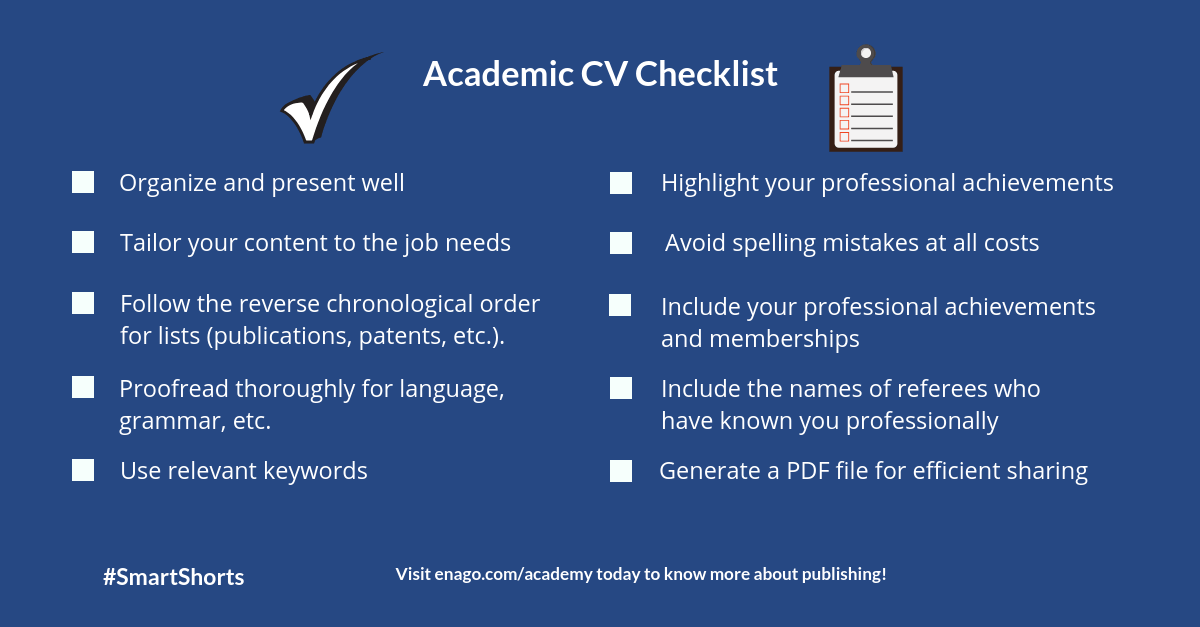How to Write an Academic CV

An ideal academic CV (Latin for “course of life”) is the first step towards your academic “dream job.” In today’s competitive environment, your CV needs to stand out in order to get you an interview. An academic CV is generally unsuitable for non-academic positions and vice versa. This form of a CV showcases both your academic and professional achievements in depth. It could include your educational history, employment history, publications, training details, skills acquired, etc. On the other hand, a non-academic CV (also called an “industry resume”) provides all necessary details in one or two concise pages. It mainly focuses on your skills, work experience, and professional achievements.
What is an Academic CV?
An academic CV is a comprehensive statement that highlights your educational qualification, research and teaching experience, published work, grants, fellowships, professional associations, awards, and any other details in your academic experience. The purpose of an academic CV is to show that you’re the best suited candidate for a faculty or research position you are applying for.
How Long Should an Academic CV be?
The length of an academic CV is not confined to a specific limit, as academic experiences of different people may vary based on their discipline and the work they have been doing. However, it can range from anywhere between 3 to 5 pages depending on your experience and the requisites of the position you are applying for.
In order to keep your academic employer interested, your CV needs to be tailored to the academic job. An academic position requires you to:
- undertake research
- publish and present your work
- teach students
- obtain funding for your research.
Therefore, you should focus on your ability to do these tasks.
How to Write an Effective Academic CV?
Pay attention to your presentation and layout
- Make sure that the font is readable and use a consistent style for font and headings.
- Use a bold font for headings in order to make it easier for recruiters to scan their section of interest.
- Use one-inch margins on all sides.
- Proofread to avoid grammatical or spelling errors.
Last comes first
List down your latest publications, experiences, and qualifications first. Recruiters are more interested in your most recent publications and your highest qualifications.
Tailor your content to the job post
It should be tailored to the position you are applying to. Highlight on aspects that interests your employer. For example, if teaching is the focus of the position, then list the relevant teaching experience first. Similarly, if the focus of the position is more on research, then list your research experience first.
Use relevant keywords
Some recruiters use the Applicant Tracking System (ATS) to help them shortlist a few CVs from the thousands they receive every month. However, as robots can only filter what they are told, automated systems have their own flaws. Therefore, applicants must ensure that their CVs contain the relevant keywords used in the job description to increase their odds of selection. CVs that get red-flagged/disqualified at an early stage never get shared with anyone from the hiring department.
Plenty of academic CV samples are available online. You can visit the University of Toronto and the University of Kent websites for relevant academic CV examples. You can also find academic CV templates online
What Should be Included in an Academic CV?
An academic CV should ideally include the following sections:
- Personal details: The header should include your name. Include your LinkedIn profile (if available).
- Education: Year completed, degree type, subjects or research topics, department and institution, honors and advisor’s name.
- Professional academic appointments: Position, institution, duration of employment, responsibilities, and courses you’ve taught.
- Publications: Categorize under sections such as books, book chapters, and peer-reviewed journal articles. Maintain a consistent bibliography style by using a reference management tool such as Mendeley Desktop.
- Achievements: List down some of the relevant awards that you have received. Do mention the grants and fellowships you have received to show that you can attract funding.
- Conferences: Use sections such as invited talks, campus talks, and conference presentations if your list is long.
- Research experience: Divide into sub-categories (e.g., full-time researcher, research associate, research assistant, etc.).
- Professional affiliations and memberships: These include volunteering, leadership roles, or memberships in any professional association.
- Additional activities: Non-academic jobs and media coverage.
- References: Include contact details of 2-3 referees after obtaining their permission first.
Final Checks
- Before you send off your CV, print and review it to ensure appropriate visibility for all relevant details.
- Make sure that details under sub-headings do not span over two pages.
- Proofread your CV several times.
- Avoid spelling mistakes at all costs! These may result in embarrassing or unintentional statements.
- Finally, convert your CV into a PDF file to ensure that the formatting is intact when it reaches your recruiter.
Do you have any other tips for our readers? Tell us about your successful academic CVs in the comments section below.










